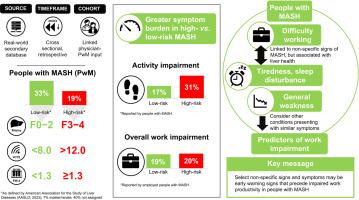Real-world work productivity is impaired in people with metabolic dysfunction-associated steatotic liver disease in the USA
IF 7.5
1区 医学
Q1 GASTROENTEROLOGY & HEPATOLOGY
引用次数: 0
Abstract
Background & Aims
The impact of metabolic dysfunction-associated steatohepatitis (MASH) on patient-reported outcomes is poorly understood. We assessed work productivity burden in a real-world population with suspected/confirmed MASH, comparing work productivity and symptoms across subgroups (risk status, age, BMI, and comorbidities) in the USA using secondary data from Adelphi Real World MASH Disease Specific Programmes™, cross-sectional surveys of physicians and consulting patients in 2019 and 2022.
Methods
Physicians (hepatologists, gastroenterologists, and endocrinologists) reported sociodemographic data and signs/symptoms for eight or fewer consecutive participants with MASH. Participants voluntarily completing questionnaires that assessed work productivity, health status, and quality of life/symptoms were categorized with low-, indeterminate-, or high-risk MASH using physician-stated fibrosis stage and derived risk categories. Principal components factor analysis identified factors from MASH signs and symptoms. Elastic net regression determined features associated with work productivity impairment.
Results
In total, 87 physicians and 429 individuals with MASH provided data. The impact of MASH on activities was greater in high-versus low-risk MASH (activity impairment score: high risk, 30.8%; low risk, 17%; p <0.001 across all risk categories). Overall work impairment scores were 18.8% in low-risk and 19.9% in high-risk MASH. Of the 14 physician-reported signs/symptoms, 11 were significantly associated with physician-stated fibrosis stage and/or derived risk category. Two clusters of signs and symptoms (‘memory loss/swelling legs/abdomen’ and ‘fatigue/sleep disturbance/insomnia/general weakness’) and female sex were the strongest work impact predictors.
Conclusions
Activity impairment was greater in participants with high-risk MASH, whereas overall work impairment was comparable, almost 20%, in low- and high-risk MASH. Non-specific symptoms of fatigue, sleep disturbance, and general weakness associated with MASH and other conditions predicted work impact in low-risk MASH. Thus, early detection and management of MASH could ameliorate work impairment.
Impact and implications
Even in its early stages, when otherwise asymptomatic, metabolic dysfunction-associated steatohepatitis (MASH) may impact the ability to work. Using the Work Productivity and Activity Impairment: Specific Health Problem (WPAI:SHP) questionnaire, we identified activity and overall work impairment in people with high- and low-risk MASH. We found a link between difficulty working and other signs, such as tiredness, sleep disturbance, and general weakness, in low-risk MASH that are not specific to MASH but can be associated with liver health. These general, non-specific signs could represent possible early warning signs preceding reduced productivity in patients with MASH.

在美国,与代谢功能障碍相关的脂肪变性肝病患者的实际工作效率受损
背景和目的代谢功能障碍相关脂肪性肝炎(MASH)对患者报告结果的影响尚不清楚。我们评估了疑似/确诊MASH的现实世界人群的工作效率负担,比较了美国不同亚组(风险状况、年龄、BMI和合并症)的工作效率和症状,使用的二手数据来自Adelphi Real World MASH疾病特定计划™,2019年和2022年对医生和咨询患者的横断面调查。方法内科医生(肝病学家、胃肠病学家和内分泌学家)报告连续8名或更少的MASH患者的社会人口学数据和体征/症状。参与者自愿完成评估工作效率、健康状况和生活质量/症状的问卷,根据医生陈述的纤维化分期和衍生风险类别,将其分为低、不确定或高风险MASH。主成分因子分析确定了MASH体征和症状的因素。弹性网络回归确定了与工作效率损害相关的特征。结果共有87名医生和429名MASH患者提供资料。与低风险的MASH相比,高风险MASH对活动的影响更大(活动损害评分:高风险,30.8%;低风险,17%;所有风险类别的p <;0.001)。总体工作障碍评分在低风险和高风险的MASH中分别为18.8%和19.9%。在医生报告的14种体征/症状中,11种与医生报告的纤维化分期和/或衍生风险类别显著相关。两组体征和症状(“记忆力减退/腿部/腹部肿胀”和“疲劳/睡眠障碍/失眠/全身无力”)和女性是影响工作的最强预测因素。结论:高风险MASH患者的活动障碍更大,而低风险和高风险MASH患者的总体工作障碍相当,几乎为20%。非特异性的疲劳症状、睡眠障碍和与MASH相关的全身无力以及其他情况预示着低风险MASH的工作影响。因此,早期发现和管理MASH可以改善工作障碍。影响和意义:代谢功能障碍相关脂肪性肝炎(MASH)在早期无症状时可能影响工作能力。使用工作效率和活动障碍:特定健康问题(WPAI:SHP)问卷,我们确定了高风险和低风险MASH患者的活动和总体工作障碍。我们发现,在低风险的MASH中,工作困难与其他症状(如疲劳、睡眠障碍和全身无力)之间存在联系,这些症状不是MASH所特有的,但可能与肝脏健康有关。这些一般的、非特异性的体征可能是MASH患者生产力下降之前可能的早期预警信号。
本文章由计算机程序翻译,如有差异,请以英文原文为准。
求助全文
约1分钟内获得全文
求助全文
来源期刊

JHEP Reports
GASTROENTEROLOGY & HEPATOLOGY-
CiteScore
12.40
自引率
2.40%
发文量
161
审稿时长
36 days
期刊介绍:
JHEP Reports is an open access journal that is affiliated with the European Association for the Study of the Liver (EASL). It serves as a companion journal to the highly respected Journal of Hepatology.
The primary objective of JHEP Reports is to publish original papers and reviews that contribute to the advancement of knowledge in the field of liver diseases. The journal covers a wide range of topics, including basic, translational, and clinical research. It also focuses on global issues in hepatology, with particular emphasis on areas such as clinical trials, novel diagnostics, precision medicine and therapeutics, cancer research, cellular and molecular studies, artificial intelligence, microbiome research, epidemiology, and cutting-edge technologies.
In summary, JHEP Reports is dedicated to promoting scientific discoveries and innovations in liver diseases through the publication of high-quality research papers and reviews covering various aspects of hepatology.
 求助内容:
求助内容: 应助结果提醒方式:
应助结果提醒方式:


